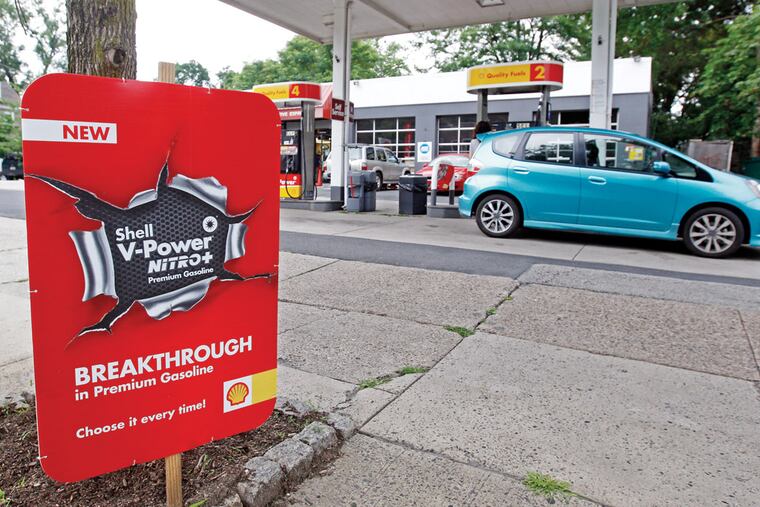Shell spends big to boost high octane and higher prices
Premium gasoline sales have declined over the decades as more motorists came to regard motor fuel as a generic commodity, and realized the pricier grades did not necessarily improve performance of their ordinary cars.

Premium gasoline sales have declined over the decades as more motorists came to regard motor fuel as a generic commodity, and realized the pricier grades did not necessarily improve performance of their ordinary cars.
But sales of premium fuel have been rebounding since bottoming out in 2008 as car-makers sell more vehicles with smaller, high-compression engines that require high-octane fuel. Oil companies are ramping up marketing for high-test, which generates bigger profits for refiners and retailers.
Shell, which calls itself the nation's leading premium-fuel retailer, last month launched an elaborate campaign to promote its new V-Power Nitro+ premium gasoline.
The oil company used Hollywood computer-graphics techniques to create a giant morphing monster (representing the engine threats of gunk, corrosion, and wear) that is hotly pursuing a BMW. The creature is tamed after the sports car refuels at a Shell station.
"We wanted to have a look and feel from our commercial that's so completely different from anything else in fuels marketing," said Dan Little, Shell's North America fuels marketing manager.
Without disclosing the campaign's budget, Little said Shell is spending three times more promoting the new fuel than it had in any previous product roll-out.
The campaign caught the attention of oil analyst Trilby Lundberg, whose newsletter last month cited Shell's "singularly gutsy gambit." Lundberg's shout-out was not so much a nod to the Shell's creativity as it was to its move to jack up wholesale prices of premium gas an average of 8 cents a gallon nationwide, and as much as 20 cents in some areas.
"We believe it's worth more than other premiums," Little said. He said Shell retailers have been able to charge more for the fuel and still increase sales.
Joseph Cunningham, who says premium accounts for 38 percent of fuel sales at the Gladwyne Shell he owns on Youngs Ford Road, said demand had been strong for the new fuel since the June 1 launch. "People are trying it, yes," he said. "Some of these people are spending $75,000 on a car, and they want it to last."
Premium fuel, which the government defines as gasoline with an octane rating greater than 90, commanded nearly half the market in most regions in the 1970s, Lundberg said.
Its market share has fallen from 20 percent in 1994 to 10 percent now, according to the U.S. Energy Information Administration.
Tom Kloza, the global head of energy analysis for the Oil Price Information Service, said premium fuel producers were now fighting over scraps.
"For all of the expensive advertisements, suppliers in recent years have watched as premium-grade ratios have shrunk to single digits - 6 percent in some markets," he said.
The quality that separates premium fuel from other grades is octane, a measure of the fuel's ability to resist knocking, or premature detonation, as it is compressed in the engine before ignition.
Premium gas was long linked to high performance because many luxury or sports cars have high-compression engines. For most cars whose makers recommend regular fuel - 87 octane in this region - the higher octane levels provide no advantage.
Midgrade fuel, introduced in the late 1980s, has an elevated octane level not exceeding 90, and was targeted for aging cars that had some knocking with regular gasoline. But its market share has declined from 12 percent to 2 percent since 1994, Energy Information Administration figures show.
Beyond octane, fuel retailers distinguished their brands with various additive packages whose primary virtue was removing carbon deposits from engine valves and fuel injectors. In 1995, the EPA set minimum standards for detergent additives so that even generic brands can claim to reduce residue.
Some brand-name fuel-makers have tried to trump the standards by adding even more than the required detergent additives. The 76 brand, owned by Phillips 66 Co., even jokingly likens the cleansing effect of its additives to a high-fiber diet for internal-combustion engines. "All it needs is five tanks for a cleaner engine," the 76 ad says.
Shell is trying to surpass other premier brands with its new fuel that claims to remedy not only gunk, but also corrosion and wear. "We're marketing on three protections, not one, like most of the industry," Shell's Little said.
He said the aim is to capture more of the premium fuel market, rather than enticing 87-octane customers to upgrade.
Analysts say premium fuel sales fatten the industry's bottom line. Lundberg said refiners have increased the spread between regular and premium fuel by 12 cents since 2010, and retailers have increased the spread for premium by a penny more.
Kloza, the oil-price analyst, is skeptical of the fancier fuels' virtues. But he says some premier brands can still move markets.
"Shell and Chevron still command a nice brand premium recognition in their core markets," he said. "Florida retailers who switch from another brand to Shell tell me it lifts their volumes of all grades by 10 to 20 percent or more. There are a lot of 'older people' in Florida who still believe that particular brands are magical."